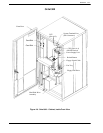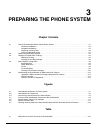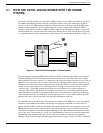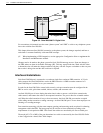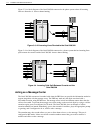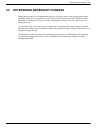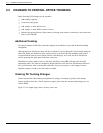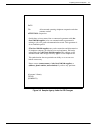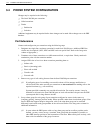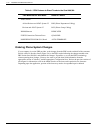
Preparing the Phone System 3-3
Octel 200/300 S.4.1PB60019−01
Integrated Installations
Different methods are used to integrate a telephone system with the Octel 200/300. In some cases, a
combination of these methods may be used for full integration.
Integration is the ability of the telephone system to provide the Octel 200/300 with information that
identifies the extension number a call was intended for and, in some cases, the extension number from
where the call originated. Integration also handles message waiting indication.
Although calls can be sent directly to the message server (as they are with an interfaced installation) most
integrated environments involve PBXs equipped with DID trunks and most calls are forwarded to the
message server rather than answered directly.
In-band Integration
In-band integration is the ability of a telephone system to send DTMF tones that identify the extension
number for a forwarded call to the port extension answering the call. In-band signalling may include the
condition (busy, ring-no-answer, or direct) for the call. In certain installations, DTMF tones may be used
to turn ON or OFF message waiting indicators to indicate when a mailbox has new messages.
RS-232C Integrations
RS-232C integrations include Centrex integrations that use the Simplified Message Desk Interface
(SMDI) and integrations with some NEC switches. The SMDI call record provides the message server
with the extension number of the called party when an incoming call is forwarded. If the call originated
in the same PE or PBX, the directory number or extension number of the calling party is also sent to the
message server.
The condition or reason the call was forwarded to the message server, as well as the port or member of
the hunt group the call is being sent to, is included in the call record. Message waiting indication may be
turned ON or OFF over RS-232C connections for most installations.
Octel 200/300 Proprietary Card Integrations
Proprietary line cards that function similarly to digital display telephones have been developed for
several different PBXs. The Octel 200/300 reads the display to collect the card record, which is used to
determine the extension and the condition for the call, and then answers the call with the appropriate
greeting or response.
Once the extension and condition for the forwarded or direct call is known, a port answers the call and
provides all remaining call processing and messaging functions. The cards also turn ON or OFF message
waiting indicators in most of the proprietary integrations.
Answering Incoming Calls
The Octel 200/300 can answer all or a portion of a company’s incoming calls. Through the PBX
programming, trunks can be directed to the Octel 200/300 hunt group instead of the operator through a
PBX feature. This feature, often called DIL (Direct In Lines), allows trunks to be directed to a specific
extension or hunt group instead of the console.
The PBX may be set up to direct all or only some incoming trunks to the Octel 200/300. For example, the
main company number may be answered by the attendant, while a second trunk group, with a different
listed directory number, can be directed to the Octel 200/300.



